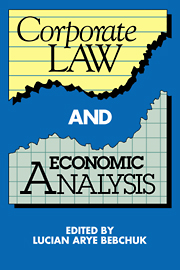Book contents
- Frontmatter
- Contents
- List of contributors
- Introduction
- Acknowledgments
- 1 Mergers, acquisitions, and leveraged buyouts: an efficiency assessment
- 2 Discounted share prices as a source of acquisition gains
- 3 Ties that bond: dual class common stock and the problem of shareholder choice
- 4 Property rights in assets and resistance to tender offers
- 5 A new approach to corporate reorganizations
- 6 The corporate contract
- 7 The state competition debate in corporate law
- 8 The positive role of tax law in corporate and capital markets
- 9 Ownership of the firm
- Index
3 - Ties that bond: dual class common stock and the problem of shareholder choice
Published online by Cambridge University Press: 15 December 2009
- Frontmatter
- Contents
- List of contributors
- Introduction
- Acknowledgments
- 1 Mergers, acquisitions, and leveraged buyouts: an efficiency assessment
- 2 Discounted share prices as a source of acquisition gains
- 3 Ties that bond: dual class common stock and the problem of shareholder choice
- 4 Property rights in assets and resistance to tender offers
- 5 A new approach to corporate reorganizations
- 6 The corporate contract
- 7 The state competition debate in corporate law
- 8 The positive role of tax law in corporate and capital markets
- 9 Ownership of the firm
- Index
Summary
Introduction
For Berle and Means in the 1930s the “separation of ownership and control” was a realpolitik account of the relationship between management and the widely dispersed shareholders of the public corporation. In the 1980s the Berle–Means metaphor may become a structural fact for many major public firms. Over the past five years, and at an accelerating pace, more than eighty public firms have adopted, or proposed to adopt, capital structures with two classes of common stock. One class, intended principally for public shareholders, carries limited voting rights; the second class, intended principally for management and its associates, carries enhanced, or “super,” voting rights. Although proposals for dual class common stock vary in their details, their effect would be significantly to unbundle corporate governance from economic participation. Overall, the move toward dual class common stock portends the most important shift in the underlying structure of corporate governance since the rise of institutional stock ownership in the 1960s and 1970s.
Firms capitalized with dual, or even multiple, classes of common stock have been a well-known feature of the corporate landscape. Closely held corporations and public firms with significant dynastic family voices have frequently used the dual class common device. However, the dual class common has typically been part of these firm's capital structure since their initial public offerings (IPOs). It is no secret that the current popularity of dual class common among public firms is a response to the recent wave of hostile takeovers.
- Type
- Chapter
- Information
- Corporate Law and Economic Analysis , pp. 74 - 117Publisher: Cambridge University PressPrint publication year: 1990
- 4
- Cited by



